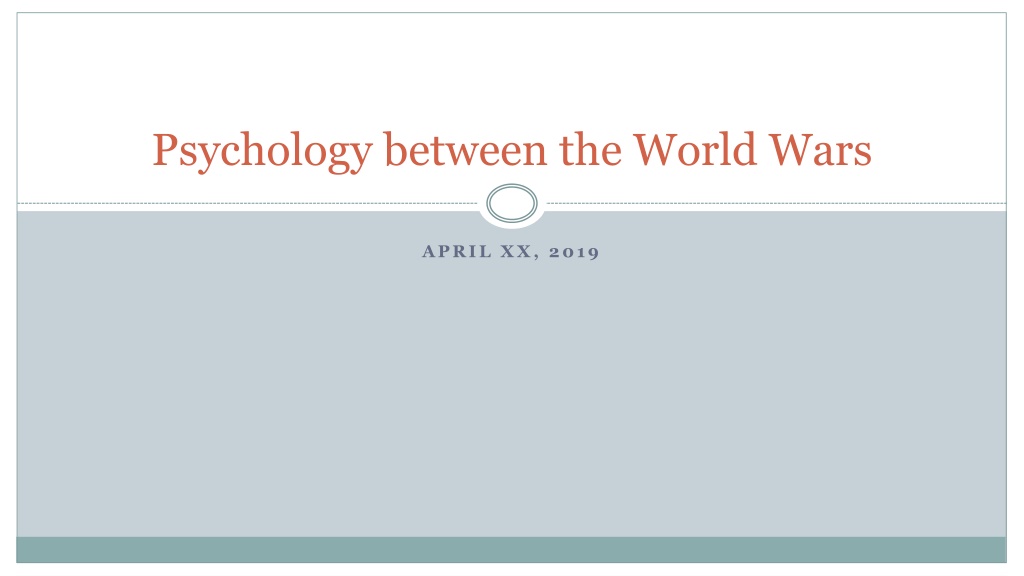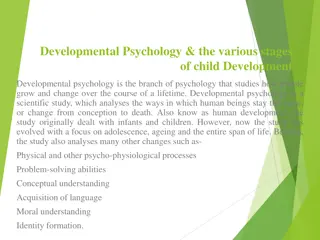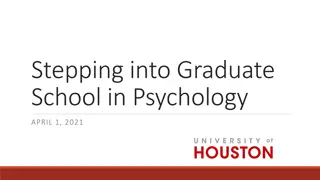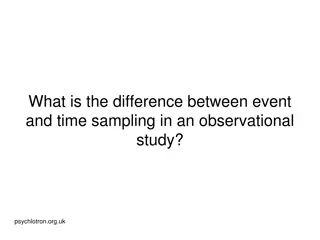Evolution of Psychology between the World Wars
Rapid changes in psychology between World War I and World War II marked a shift towards the U.S., driven by economic, social, and educational factors. Barriers in psychology began to diminish, with more women entering the field despite obstacles. Notable figures like Lev Vygotsky and Jean Piaget revolutionized the study of cognition and child development. Vygotsky's emphasis on social learning and the zone of proximal development challenged traditional views of education and learning potential.
Download Presentation

Please find below an Image/Link to download the presentation.
The content on the website is provided AS IS for your information and personal use only. It may not be sold, licensed, or shared on other websites without obtaining consent from the author.If you encounter any issues during the download, it is possible that the publisher has removed the file from their server.
You are allowed to download the files provided on this website for personal or commercial use, subject to the condition that they are used lawfully. All files are the property of their respective owners.
The content on the website is provided AS IS for your information and personal use only. It may not be sold, licensed, or shared on other websites without obtaining consent from the author.
E N D
Presentation Transcript
Psychology between the World Wars APRIL XX, 2019
Overview Rapid Changes in Psychology Cognition & Development Lev Vygotsky Jean Piaget Personality & Social Psychology
Rapid Changes in Psychology Between World War I and World War II, psychology changes rapidly Major seat of psychology moves toward U.S. Why? Economic reasons Social reasons Education still boomed
Rapid Changes in Psychology Barriers slowly begin to come down More women choosing careers in psychology, not without obstacles Women in the APA: 1917 13% 1923 18% 1928 34% 1938 30% First African American psychologist Francis C. Sumner (1895 1954) Received PhD from Clarke University in 1920 Established department of psychology at Howard University
Cognition & Development Begin to see work on relationship between child development & cognition Up to this time, children were basically viewed as little adults Primarily Lev Vygotsky Jean Piaget
Lev Vygotsky (Moscow; 1896-1934) Acquired degrees in law and history/philosophy Attended Moscow State University through a Jewish Lottery Studied child development and special needs using observation, unstructured interviews, and simple procedures Work blended philosophy, Marxism, evolutionary theory, and developmental and experimental psychology Died at a young age due to tuberculosis
Lev Vygotsky Learning occurs socially Through interaction with our environment and communication with others We internalize what is learned and can make it our own
Lev Vygotsky Zone of proximal development The difference between what a child has learned on its own and what it could learn with the help of an instructor Learning potential Implications Children are ready to learn more and understand better than their teachers or parents assume What does this mean for school curricula? What does this mean for standardized tests?
Jean Piaget (Geneva/Zrich, Switzerland; 1896-1980) Took up psychology after working with Alfred Binet Focused on developmental issues Believed that cognitive processes develop in stages that are different from previous or future stages Like Vygotsky, had a complex method: Naturalistic observation Psychometrics Clinical interview
Jean Piaget Theorized that children go through four stages of development: Sensorimotor Preoperational Concrete operational Formal operational Each stage builds on the previous one through two learning processes: Assimilation: the process by which we place new information into an existing schema Accommodation: the process by which we create a new schema or drastically alter an existing schema to include new information that otherwise would not fit into the schema
Lasting Impact of Vygotsky & Piaget Further our knowledge of child development Directed focus of parents and teacher to children s creativity, individual choices, and nonconforming attitudes Essentially, emphasized children s individuality They re not just little adults!
Personality Personality was not a new idea Several scientific and social traditions had an impact on the study of personality: The empirical and experimental methods and views of Galton Not an abstract concept but a measurable combination of features and traits, some stable constructs of an individual s behavior and thinking Tradition of French clinical experimentation Based on methods distinguishing a fully functional personality from a dysfunctional, problematic, or pathological one American tradition emphasizing the importance of moral features in an individual s behavior
Gordon Allport (Cambridge, MA; 1987-1967) Influenced by work of William Stern IQ First trait approaches to personality Personality consists of a distinct collection of qualities or traits Personality viewed as the fundamental patterns that an individual forms over the course of his or her experience Emphasized distinction between personality and character Character viewed as a moral category
Gordon Allport Allport s traits: Cardinal traits Traits that dominate and shape a person s behavior Ruling passions or obsessions Central traits General characteristics found to some degree in every person Basic building block, but not as influential as a cardinal trait Secondary traits Characteristics that can only be seen in certain circumstances May only be known to those close to you
Gordon Allport Distinguished between two approaches to studying personality: Idiographic Focuses on each individual as a unique whole Tries to understand how to traits and other personality variables become integrated in each unique individual Nomothetic Attempting to arrive at general laws that apply to all humankind Studying one or more traits or variables across a large sample
Early Social Psychology Three areas of contribution: Theories of social instincts Groups are social organisms with their own features When in groups reason is abandoned, instinct takes over The attitudes of a few can spread throughout the group Experimental social psychology Finding: competition improves performance among solo athletes Muzafer Sherif group decision-making Robbers cave experiment Theories of social judgments Discrepancies in thinking and behavior prejudice Gestalt influence need for good form creates bias
Looking back & looking ahead Psychologists grew in number APA memberships tripled between 1920 and 1930 Studies become more diverse Everything wasn t psychoanalytic, behaviorist, or Gestalt Testing rises in popularity Not without its setbacks applicability, methodological issues Developmental research emerges as a contrast to psychoanalysis and behaviorism

 undefined
undefined









































